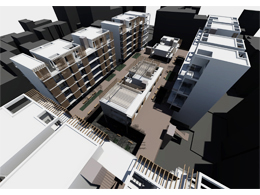STUDENTS PROJECTS
PROJECTS2015

27 October, 2015
New residential complex in the area of St.Dionisios in Patras, Greece
This design thesis attempted to investigate the design of an environment that encourages the sense of the community and the creation of coexistence values, so as not to let the users be passive occupants of the building.
Student: Paraskevi Boulakou
Supervisor: Dimitris Giannisis
Patras School of Architecture, University of Patras
Presentation date: 26.06.2015

The big economic changes of recent years, led to new thoughts about the dwelling, revising and reviewing its relationship with the society. The current crisis led to the end of the decade of exaggerations. The past decade's dominant standards of living, the individual eudemonism and the emphasis on consumerism, belong now to the past.
The new economic reality brings back the sense of proportion in architectural design. Similarly, the environmental crisis sets the concept of sustainability at the heart of contemporary urban problematic. We are looking for new standards of living in new residential complexes, which include small dwellings for students, workers, families and shared workspaces for the above groups. The design of the complexes should focus on the study of the special characteristics of the region and the possibility of reforming its identity. We investigate proposals for new types of mixed buildings where the dwelling participates in the public space, it does not play a leading role and creates building complexes that fall into the existing tissue. Furthermore, this design thesis attempted to investigate the design of an environment that encourages the sense of the community and faces the anonymity of city life. The residents are sharing the communal functional zones and create conditions of collectivity. In addition, we study the dwelling in relation to the urban density, the traffic connection and the social environment.
During the thesis' research I have focused on two scales: areas of the city which attract me and human-users. So, I chose the area of St. Dionisios, which belongs to the area of St. Sophia in the city of Patras, a few meters from the old port zone. From the early 20th century the neighborhood of St. Dionisios was that with the most intense political, cultural and sporting efficiency in Patras, due to the existence of the church that characterized the architecture of the neighborhood and the historic industrial building of the 1st quarter of the 20th century, at the intersection of St. Dionisios street with Norman Street, which has recently been converted to multi-space and art gallery.
Subsequently, the current situation of the study area was evaluated. Therefore, I have created some diagrams that present the results of that study. Many tall buildings and several abandoned ones are identified. At the ground floors of the buildings there are more shops and a few dwellings, while above dominates the use of the dwelling. There are a few bus and train lines across this area, which several groups of people can use, but there is also lack of parking spaces. So, based on the initial research, the buildings in the study area are in poor condition. The intermediary places are residual, as no urban or collective public function appears. There is a lack of green public spaces, traffic problems, lighting, ventilation of buildings problems and lack of parking spaces. According to the diagrams that show the quantity of occupants of the buildings, the amount of inhabitants of the building blocks, the habitation density diagram and the quality characteristics of the building blocks, we are leading to the problematic building blocks.
The proposal's strategy follows these basic principles:
The four blocks, with the biggest problems according to habitation density diagram and their quality characteristics, are not being kept.
Conversion of the solid building block, the ground floor is released from the dwellings and we keep a number of commercial and collective uses. The open space-yard-collective space is raised from the ground floor to the first floor, where towers-habitation units are placed.
The exterior corridors-routes facilitate the circulation in the buildings, the dwelling's accessibility and protect the privacy of residents.
Collective actions, in the "controlled public space" of the first level and in the gaps of the dwellings at the second central level, are imported. Therefore, interaction sites for the users are being created.
The general intention is to perceive the collective areas as an opportunity to create a public space made for interaction between the neighbors. So, we create a residential complex that will house the residents, providing them with apartments of equal value in use as the present and will be the center of attraction for new residents. Furthermore, the central Norman Street, which is the axis to the coastal zone, is pedestrianized. The general intention in the design of residential complexes is to create coexistence values without the users be passive occupants of the building. Conversion of the conceptual character of the dwelling, from habitation engine to heart of everyday actions, by creating more public spaces and workplaces for its users.
















